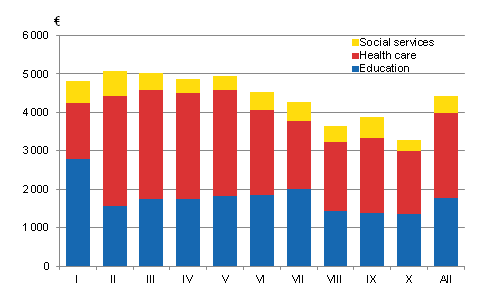Published: 28 April 2014
Economic significance of welfare services is biggest for families with children
Finnish households profit around EUR 7,400 per year, on average, from the welfare services provided by society. The monetary value of the used services is over 20 per cent of households' consumption expenditure. The use of services is most versatile among families with children, for whom welfare services have the biggest economic significance. By using day care services, child health clinics and comprehensive school, the monetary value of the services used by a two-parent family with children is nearly EUR 18,000 and that of a single-parent family EUR 14,000 per year. These data are based on the data of Statistics Finland's Household Budget Survey in 2012.
Monetary value of houseold consumption expenditure and public welfare services in 2012

* Only those aged 65 or over
Necessary and central services affecting the population's well-being are financed largely through taxation in Finland. These welfare services include education, health care and social services. When the monetary value of these welfare services is added to household consumption expenditure, the so-called actual individual consumption expenditure is obtained. The concept is used to describe how the services paid with tax revenue are allocated in the population and what effect the services have on households' subsistence.
The use of services and the monetary benefit derived from the services is linked to the households' stage in the life cycle. The services are used most by families with children, to whom schooling and day care services are topical. For single-parent families, the monetary value of the services is nearly 40 per cent of the household's total consumption expenditure. In other words, if welfare services were financed fully with customer payments instead of tax revenue, the net income of a single-parent family should be 40 per cent higher to maintain the current consumption level. In relative terms, the services have the least significance for childless couples. For them, the monetary benefit from the use of the services is, on average, around EUR 4,800, which is 11 per cent of consumption expenditure.
It is not often worthwhile to compare the income or expenditure of household with many members with that of a single-person household, because the number and age of household members largely determine the level of consumption. Households’ expenditure is generally compared by dividing the expenditure by the number of consumption units 1) in the household. Thus we can get a comparable figure for households of different sizes and ages. As a concept, one consumption unit corresponds to the consumption of one adult living alone (see the footnote). When the value of services and disposable income are proportioned to the number of household consumption units, the monetary benefit gained from the use of services can be compared in different income brackets.
Monetary value of welfare services by consumption unit and income bracket on 2012

The economic significance of public welfare services is greater for low income than high income earners. The income bracket with the highest income (X) uses services to the value of around EUR 3,300 and that with the lowest income (I) EUR 4,800 per consumption unit. In euros, the difference is less than 1.5 times as high, but in relation to the rest of consumption it is multifold. In the income bracket with the lowest income, the value of services account for 37 per cent of consumption expenditure, while in the income bracket with the highest income the corresponding proportion is eight per cent.
Social services are used equally much regardless of the income level. For the lowest earning decile, free education services have the most economic significance, but they use health care services less than others. Over one-quarter of this group are student households. On average, education and health care services have more or less same economic significance to households. Social services are used only in certain stages in the life cycle, when children are at day care age and when old age or other reasons require external help for coping with everyday life at home. For that reason, the economic significance of social services is on the whole much lower.
These data appear from the interview and register data selected for the sample of the Household Budget Survey in 2012. When interpreting the results, it should be noted that persons living in institutional care do not belong to the population of the Household Budget Survey, for which reason the institutional care of old people and old-people's homes are not included in the calculations. In addition to public services, the value of services is formed from the compensations by the Social Insurance Institution paid for the use of private sector services, but it does not include social allowances or other social current transfers.
1) The consumption units are based on the so-called OECD's modified scale. One adult in the household is one consumption unit. Other persons in the household aged at least 14 are 0.5 consumption units each and children aged 0 to 13 are 0.3 consumption units each. A household with one adult member is one consumption unit, while a household consisting of spouses and one child aged under 14 together are 1.8 consumption units. Consumption calculated by means of consumption units takes into account the size differences between households and enables their comparison with one another.
Source: Households’ consumption 2012. Statistics Finland
Inquiries: Mira Kajantie 09 1734 3626, Tarja Hatakka 09 1734 3553, kulutus.tilastokeskus@stat.fi
Director in charge: Riitta Harala
Publication in pdf-format (194.9 kB)
- Tables
-
Tables in databases
Pick the data you need into tables, view the data as graphs, or download the data for your use.
Updated 28.4.2014
Official Statistics of Finland (OSF):
Households' consumption [e-publication].
ISSN=2323-3028. 2012. Helsinki: Statistics Finland [referred: 1.1.2026].
Access method: http://stat.fi/til/ktutk/2012/ktutk_2012_2014-04-28_tie_001_en.html

